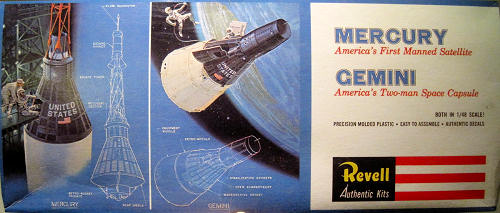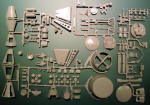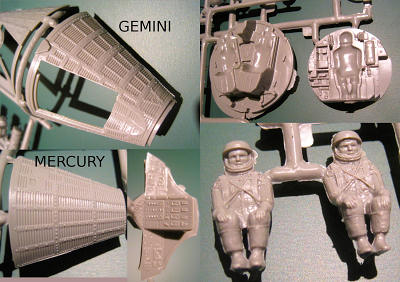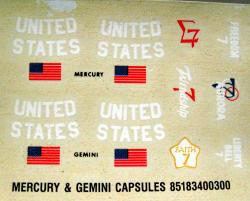
Revell 1/48 Mercury & Gemini Spacecraft
| KIT #: | 1834 |
| PRICE: | $ |
| DECALS: | Each Mercury and generic Gemini |
| REVIEWER: | Richard F. |
| NOTES: |

| HISTORY |
By the end of 1963, the "Space Race" was really heating up. The USSR had leapt
to a great start in what President Kennedy called "space achievement" -
launching humanity's first satellite into orbit in 1957 and its first human,
Yuri Gagarin, in April 1961. The little Mercury spacecraft was America's first
answer. A tiny tin can with a man inside, it only had a window and flight
controls because the test pilots who were the "Original Seven" astronauts
demanded it. Mercury flew two sub-orbital and four orbital flights in the two
years from May 1961. By then the Soviets had flown six orbital missions,
including the first man, and first woman, in space.
The only flight in 1964 was the Soviet Voskhod 1, the first multi-crew mission
with three cosmonauts. It was a great achievement, on the face of it, but behind
the scenes it was a tremendous risk. The three flew without spacesuits, because
the ship was such a tight squeeze. In 1971 this would be shown to be foolhardy,
when three cosmonauts on a Soyuz flight died when the air leaked out of their
craft during re-entry. The first flight of 1965 was another Soviet achievement -
Alexei Leonov's first-ever human spacewalk. Again, this turned out to have been
incredibly risky, as Leonov's spacesuit ballooned up. He was almost unable to
get back inside, and years later reportedly said he had a suicide pill with him,
just in case. Still, the US appeared to be behind the pace.
But the tide turned in 1965. After Leonov's flight, the next ten missions over
1965 and 1966 were all American. The remarkable Gemini program was in full
swing. If Mercury was a tin can with a man inside, Gemini was a sports car or
fighter jet. A two-seat craft capable of autonomous manouvers and able to
rendezvous and dock with other spacecraft, Gemini was the absolute cutting edge
of aerospace technology. In ten flights, five each year, Gemini astronauts
pulled off the first real space rendezvous, the first docking (with the Agena
booster rocket), the first working spacewalk (after several tries) where the
astronaut could really work outside, rather than just float around, and
demonstrated a host of other space techniques for the first time. It wasn't all
plain sailing - there was a close call on Neil Armstrong's mission that was only
averted by his piloting skill.
But by the end of Gemini in November 66, the US was in a very strong position
for the push to the moon.
And yet 1967 was a terrible year for both countries. The notorious launch pad
fire of Apollo 1 killed astronauts Grissom, White and Chaffee in January. And
the only spaceflight that year ended in disaster when Cosmonaut Komarov
discovered that his Soyuz 1 parachute was faulty. He crashed to his death in
April.
The US bounced back faster. Only the next year, the Apollo 8 had circumnavigated
the moon, and in June, 1969...well, the rest is history.
| THE KIT |
 Revell
is apparently re-releasing this fairly ancient kit soon. I bought mine when it
was re-released in the mid-1990s. It first came out before the Gemini program in
the early 1960s. You can tell this in two ways. First, the decals only really
provide the full markings for the Mercury spacecraft, and second, the Gemini kit
contains the proposed skid landing gear that was going to be on Gemini but was
later canned.
Revell
is apparently re-releasing this fairly ancient kit soon. I bought mine when it
was re-released in the mid-1990s. It first came out before the Gemini program in
the early 1960s. You can tell this in two ways. First, the decals only really
provide the full markings for the Mercury spacecraft, and second, the Gemini kit
contains the proposed skid landing gear that was going to be on Gemini but was
later canned.
It's a great kit though. I've seen both Mercury and Gemini spacecraft at museums
in the US, and for my money, this kit captures the surface texture of the real
thing quite nicely. Yes, I am sure it is a bit overscale, but it looks right to
me.
You see these things in real life and realise how tiny they are. Gemini 7 is on
display in Washington DC and when you look inside, you wonder how on Earth (I
mean, how in Heaven) Borman and Lovell survived in there for 14 days. As one of
them said, it was like living in a trash can for 2 weeks. Inside the tiny Gemini
model, and even smaller Mercury, there
are pretty decent efforts at
 interior
detail, especially the Gemini control panels. The kits both allow you to have
the spacecraft doors open and each one comes with an astronaut to go inside.
interior
detail, especially the Gemini control panels. The kits both allow you to have
the spacecraft doors open and each one comes with an astronaut to go inside.
I appear to be missing my member of the Mercury Seven but the instructi ons
indicate he came with the kit. He's probably down at the Chevy dealer picking up
his free Corvette.
ons
indicate he came with the kit. He's probably down at the Chevy dealer picking up
his free Corvette.
Decals:
As you can see, these are pretty basic. I don't know how will mine will have
held up since the mid 1990s. They'll no doubt need some serious help to fit
smoothly over the wrinkled outer surface of the spacecraft. You get "United
States" and some flags, and then for the Mercury missions you also get a mission
insignia.
| CONCLUSIONS |
There are a couple of update sets available especially for this kit from Real
Space Models. The Gemini kit upgrades your model to an on-orbit configuration of
any of the missions (and you can find pictures to model by, especially of the
rendezvous mission where each crew photographed the other). The Mercury set
gives you a whole new outer shell plus some interior parts, and you can choose
from the spacecraft that had portholes or the ones that had windows.
But even without those, I think this kit will give a pretty satisfying result to
most builders. Serious real space modelers will want to make modifications, but
the basis for a fun and rewarding build is right there in the box.
February 2012 If you would like your product reviewed fairly and
fairly quickly , please
contact
me or see other details in the
Note to
Contributors.